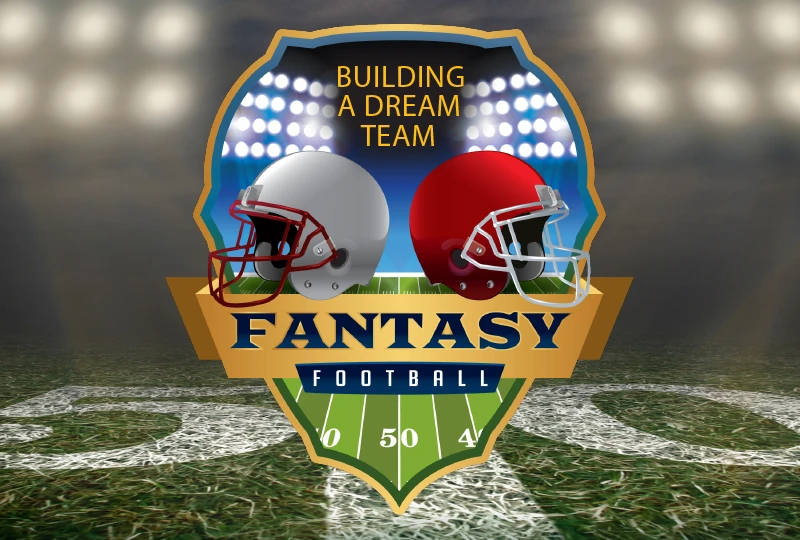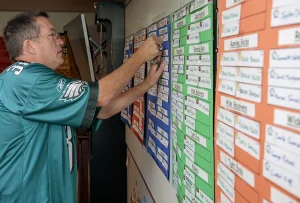by Amanda Milewski, photography by Nikola Tzenov
Building A Dream Team
A Popular Pastime Grounded In Reality
According to some accounts, modern-day fantasy football dates back to 1962. Bill Winkenbach was a businessman and part-owner of the Oakland Raiders. Winkenbach, along with Raiders PR man Bill Tunnel and Oakland Tribune sportswriter Scott Stirling, developed the rules and a system of organization that laid the foundation for today’s leagues and gameplay.
The original rulebook noted that the purpose of the game, known as the Greater Oakland Professional Pigskin Procrastinators League, was to convene some of the area’s armchair quarterbacks to face off against each other and lead to more detailed coverage of the daily happenings in the professional football league.
Some six decades later, their fledgling league has single-handedly impacted NFL consumption. According to a 2002 NFL survey, regular viewers watched 6.6 hours of NFL football per week compared to 8.4 hours by those who participated in fantasy football leagues. In 2022, 29.2 million fantasy football players were involved in an $11 billion empire.
Longtime fantasy footballer—30-plus years—and commissioner of his primary league, Finksburg resident Mike Ninosky explains that because fantasy football teams consist of players from many teams, participants are interested in watching more than just the team they usually cheer for. “If your favorite team is 8-2 or injuries are killing them, you at least have reasons to still be excited about watching football,” he says.
Fantasy, But Based On Reality
Many types of fantasy football leagues exist—pick ’em, salary cap, standard scoring, points per reception, and full fantasy. How a team fares in a particular league results from individual players’ statistics, which change weekly.
Ninosky and his brother, Bryan, established how they wanted their league to operate and fine-tuned it along the way to make it as engaging as possible. The league is an “average per league, where main points are based on yards per carry and yards per catch,” he explains.
Fantasy football allows players to test their knowledge of the game and their ability to predict what might happen each week against other players in the league.
Some leagues go for the big money. Participants in Ninosky’s league play for a bit of money but mostly bragging rights.
The player who finishes last at the end of the season must cater to next season’s draft, which Ninosky hosts in his basement using an old-school, paper-and-pencil, mounted-poster-board method.
Although the internet has revolutionized the game of fantasy football—statistics are available in real time, all the time—and numerous websites host leagues, Ninosky’s league reverted to the paper-and-pencil method for their draft after trying it online several times.
In the days before the internet, Ninosky bought a copy of USA Today on Monday or Tuesday because the paper printed all the statistics from the previous week’s games. He’d use the information to calculate the standings manually. Now, he uses a website to host the league, and each participant can log in to check players’ statistics.
Not Only For Men
According to the North American Society for Sports Management (NASSM), women comprise almost 38% of fantasy football league participants and are the market’s fastest-growing segment.
NASSM cites five reasons women play fantasy football, three of which—to enjoy, enhance, and socialize—are echoed by men who play. Regardless, the organization contends that women also play for the challenge of defeating men in a male-dominated environment and connecting with NFL players on a deeper, individual level.
Kami Behr, an occasional football viewer, participates for enjoyment and socialization. “I thought doing fantasy [football] would be fun, especially with our family and friends. Our group has known each other a long time,” she explains, since their two adult sons were in elementary school.
She and her husband, Jamie, have played in a league with sons Conor and Tyler and Tyler’s wife, Olivia, for three years.
Although Jamie is a die-hard Ravens fan and an overall football fan, he was never really interested in fantasy football. Both of their sons are in multiple leagues, and “watching how frustrating it can be was a bit of stress I did not want to have with a sport I like to watch and enjoy,” he says. “But, as Kami said, this group is like a family, so no stress, just fun.”
“Our friends, Nathan and Lisa Halstead, decided to put this [league] together as a means for both of our families and friends to play with our adult kids who all went to school [in the county],” Kami adds.
In addition to bragging rights, the Behrs’ league includes a monetary prize for the winner and a charitable component. In the first year, “we collectively decided that the winner would decide their prize and donate half of their pot to charity,” explains Jamie. “The first year we donated to the charity in honor of Chris Knorr, a friend known to all [participants], who passed away very unexpectedly.”
Last year, they donated to the Alzheimer’s Association in honor of Kami’s dad, who passed away due to dementia complications. In the second year, they donated to the Wounded Warrior Project.
Connecting With Family and Friends
Like Ninosky and the Behrs, Tyler Ports plays fantasy football to connect and compete with friends. He has been playing since 2008, when he was in seventh grade.
A devout Patriots fan who cheers for the Ravens when necessary, he has “always followed players from different teams. When I was introduced to [fantasy football], I was immediately hooked!”
Ports plays in several different leagues, all online and all for money, although the amounts vary. Some drafts are in person, which “are a lot of fun and an excuse to hang out with friends, talk a little trash and prep for the upcoming football season,” he says. All of Ports’ teams are in leagues with co-workers, friends or friends’ families.
He acknowledges that playing in multiple leagues and keeping up with the teams’ and players’ stats means that he watches a lot of football, “almost 16 hours a week, although I’m doing other things while watching. I promise,” he says.
Being in multiple leagues is a time-consuming commitment. “You have to track players based on their schedules, health, the weather for game day, matchups that week.” With games on Mondays, Thursdays and Sundays, “it’s something I pay attention to almost every day,” Ports adds.
Although his 3-year-old son Reece loves watching golf with his dad, Ports says he isn’t into football … yet.
The Behrs are on the opposite end of the football-viewing spectrum. Jamie estimates that he spends five to six hours per week watching football, and Kami watches only for two to three hours. They both spend minimal time scouting and tracking players in the off-season.
Like the Behrs, Ninosky’s main league is an intergenerational activity. He and his brother tried for 10 years to get his father to play along with them, but “he didn’t want to embarrass himself because he didn’t know any of the players,” Ninosky recalls.
After his brother passed away, their father took over the team. After the very first season, he knew all the players and had caught the fantasy football bug. “Starting in February, when we get together for our weekly dinner, my dad and I are already talking about next year’s fantasy football. It’s wonderful for my dad and probably his No. 1 hobby right now. He doesn’t use computers very much, so he still ranks all his players on paper and has a big binder that he keeps all his football notes in,” Ninosky says.
Fantasy football offers players of all skill and commitment levels the chance to “manage a football team as successfully as possible with as many good players as possible,” Ninosky says. It can be as competitive and time-consuming as you want it to be, but even with minimal effort, it’s still plenty of fun.



